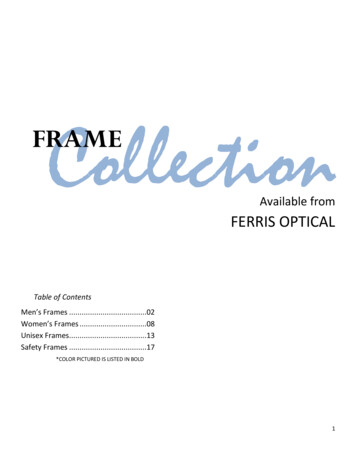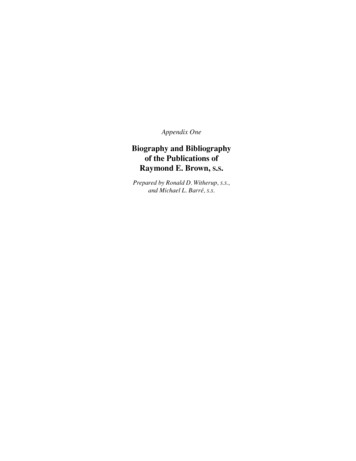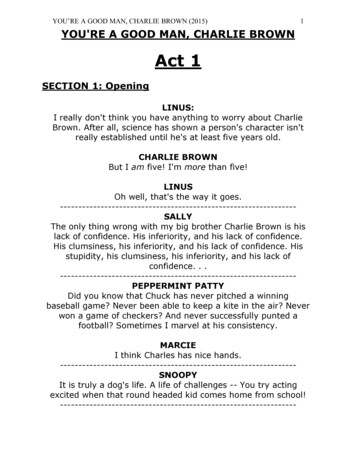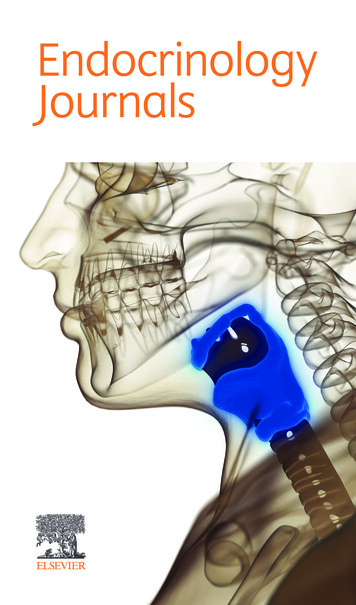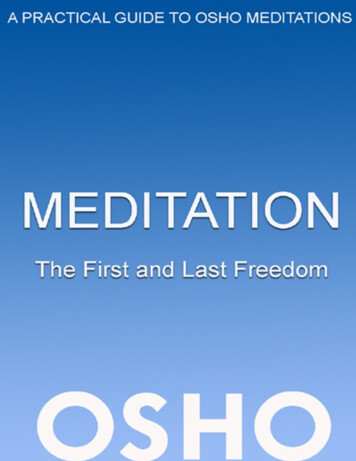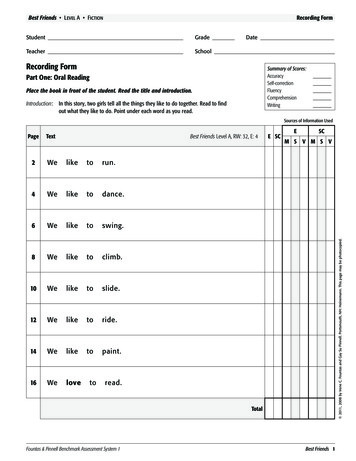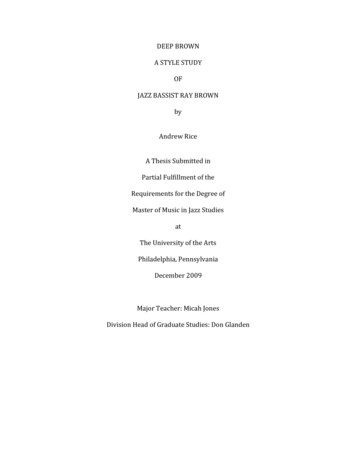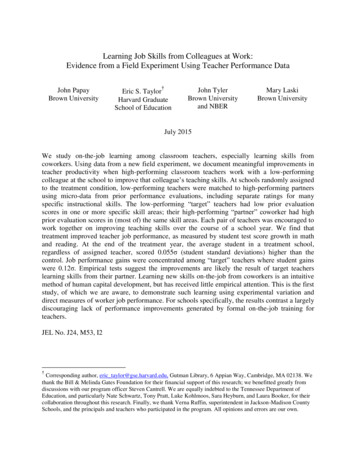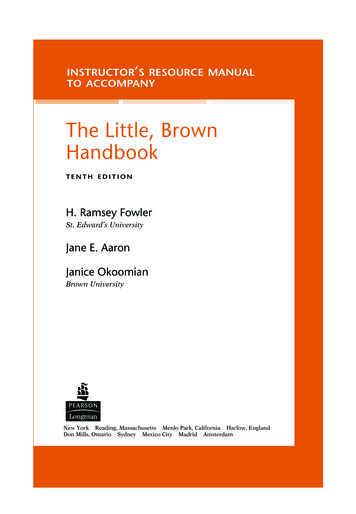
Transcription
IRM 10e Final ppi-iv6/18/067:09 PMPage iINSTRUCTOR’S RESOURCE MANUALTO ACCOMPANYThe Little, BrownHandbookTENTH EDITIONH. Ramsey FowlerSt. Edward’s UniversityJane E. AaronJanice OkoomianBrown UniversityNew York Reading, Massachusetts Menlo Park, California Harlow, EnglandDon Mills, Ontario Sydney Mexico City Madrid Amsterdam
IRM 10e Final ppi-iv6/27/061:05 PMPage iiInstructor’s Resource Manual to AccompanyThe Little, Brown Handbook, Tenth EditionCopyright 2007 Pearson Education, Inc.All rights reserved. Printed in the United States of America. Instructors may reproduce portions of this book for classroom use only. All other reproductionsare strictly prohibited without prior permission of the publisher, except in thecase of brief quotations embodied in critical articles and reviews.Please visit our Web site at http://www.ablongman.com/littlebrown.ISBN: 0-321-43544-31 2 3 4 5 6 7 8 9 10 –DOC – 09 08 07 06
IRM 10e Final ppi-iv6/18/067:09 PMPage iiiCONTENTSDesigning and Teaching Composition Courses 1Teaching Writing as a Process 2Using The Little, Brown Handbook 10Working with Student Writing 30Using Collaborative Learning with the Handbook 52Using Computers to Teach Writing 66Teaching Writing to ESL Students 1011 The Writing Process 11512345Assessing the Writing Situation 116Developing and Shaping Ideas 127Drafting and Revising 140Writing and Revising Paragraphs 153Designing Documents 1712 Reading and Writing in College 17767891011Writing in Academic Situations 178Studying Effectively and Taking Exams 181Forming a Critical Perspective 185Reading Arguments Critically 199Writing an Argument 209Reading and Using Visual Arguments 2193 Grammatical Sentences 2251213141516Understanding Sentence Grammar 226Case of Nouns and Pronouns 247Verbs 252Agreement 263Adjectives and Adverbs 2694 Clear Sentences 275171819202122Sentence Fragments 276Comma Splices and Fused Sentences 281Pronoun Reference 286Shifts 290Misplaced and Dangling Modifiers 294Mixed and Incomplete Sentences 3005 Effective Sentences 30523 Emphasizing Ideas 306iii
IRM 10e Final ppi-iviv6/18/067:09 PMPage ivContents24 Using Coordination and Subordination 31225 Using Parallelism 32026 Achieving Variety 3246 Punctuation 331272829303132End Punctuation 332The Comma 335The Semicolon 347The Apostrophe 352Quotation Marks 356Other Punctuation Marks 3607 Mechanics 36733343536Capitals 368Underlining or Italics 371Abbreviations 374Numbers 3768 Effective Words 3793738394041Using Appropriate Language 380Using Exact Language 386Writing Concisely 393Using Dictionaries 398Spelling and the Hyphen 4039 Research Writing 40942434445464748Planning a Research Project 410Finding Sources 418Working with Sources 426Avoiding Plagiarism and Documenting Sources 435Writing the Paper 439Using MLA Documentation and Format 443Two Research Papers in MLA Style 44710 Writing in the Academic Disciplines 4514950515253Working with the Goals and Requirements of the Disciplines 452Reading and Writing About Literature 455Writing in Other Humanities 462Writing in the Social Sciences 465Writing in the Natural and Applied Sciences 47011 Special Writing Situations 47554 Writing Online 47655 Public Writing 48256 Oral Presentations 488
IRM 10e INTRO Final pp01-1146/18/067:09 PMPage 1Designingand TeachingComposition CoursesCHAPTER1Teaching Writing as a ProcessCHAPTER2Using The Little, Brown HandbookCHAPTER3Working with Student WritingCHAPTER4Using Collaborative Learning with the HandbookCHAPTER5Using Computers to Teach WritingCHAPTER6Teaching Writing to ESL StudentsThese chapters appear only in this Instructor’s Resource Manualand the Instructor’s Annotated Edition
IRM 10e INTRO Final pp01-114CHAPTER6/18/067:09 PMPage 21Teaching Writing as a ProcessWRITING AS A HOWDrawing on the results of three decades of research into the composing processes of writers, most writing instructors now emphasize the howof writing. While theorists such as Lester Faigley and Susan Miller havepointed out the limitations of trying to define systematically what happenswhen a writer sits down to compose a work, most writing teachers andtheir students have effectively adapted a focus on the processes throughwhich students generate and revise their writing, rather than focusingsolely on a final product. This book is designed to support that focus onthe hows of writing.Most writers agree that at least three components contribute to theprocesses they use most of the time: prewriting, the finding and exploring ofideas and the construction of plans for expressing them (in classical terminology, invention); drafting, getting the ideas down on paper and generatingsentences about them; and revising, reconsidering the ideas, the treatmentthey receive, the plans for expressing them, and the ways they are expressed(in classical terminology, arrangement, style, and to some extent, delivery).Theories about the writing process have focused on the ways in whichwriters do the following: perceive and explore themselves and their worlds through the mediumof language;consider their subject matter as the occasion for interpretive analysisand as the testing ground for ideas and hypotheses;respond to, understand, and to some degree, invent their audiences;andposition themselves in relation to writerly conventions, to institutionalrestraints, and to communities within and outside of the classroom.These assumptions are based on the theories outlined below.WRITING AS AN EXPRESSIVE PROCESSMany theories of the writing process from the 1960s and 1970s focused onits expressive content, the attempts of writers to use language to capture andarticulate the unique vision of the writer. For instance, D. Gordon Rohmanand Albert O. Wlecke argue that techniques such as meditative exercises,2
IRM 10e INTRO Final pp01-1146/18/067:09 PMPage 3Writing as a cognitive process3journal keeping, and the composition of analogies (called “existential sentences”) help writers find a personal truth in even the most abstract of subjects. They argue that such “prewriting” techniques lead in a smooth andlinear fashion to drafting and revision as writers refine the expression of thetruth they tell. This privileging of self-discovery, what is sometimes calledthe expressionistic or romantic view of composing, is also held by PeterElbow, Ken Macrorie, William Coles, and Donald Murray, to name a few ofits most influential proponents. Elbow argues for the efficacy of freewritingand drafting in helping writers explore ideas before worrying about structure and presentation. Macrorie encourages students to use “case histories”of past experiences and to work from direct observation in order to gobeyond the obvious clichés, which he calls “Engfish” (because they stink ofinsincerity). Coles values prewriting because it allows students to exploremultiple relationships to readers and subjects (what he calls “plural I’s”).Murray emphasizes aspects of prewriting that cultivate surprise, originality,and new combinations of ideas that lead to personal discovery.The expressionistic theory gives discovery of ideas primacy in the writing process and sees the writer’s personal vision as more important thanconventions and codes; its emphasis on pre- and freewriting is an attemptto give writers the power to control or even exploit conventions and expectations in the interests of conveying an original vision. These beliefs havethus attracted criticism from those who believe that the teacher’s responsibility is to show writers how to become part of a community, not how toput themselves outside it. However, the expressionists’ contributions toour understanding of the formative stages of prewriting and drafting andtheir respect for students as writing colleagues have benefited many teachers and theorists. Ann Berthoff’s work is an interesting example of thatinfluence; she draws on the expressionistic emphasis by stressing thepower of the imagination to create relationships between ideas, but in“Recognition, Representation and Revision” she also develops an understanding of revision as a nonlinear part of the composing process, anongoing reconsideration of those relationships. Where many expressionists might insist that pre-writing generates the ideas, that revision is theprocess of getting them right, and that editing is the radically separate taskof adjusting the etiquette of presentation (spelling, punctuation, and thelike), Berthoff and others view revision as a recursive process, as the meaningful reconsideration and development of ideas articulated through thegrammar of the paragraph and the sentence.WRITING AS A COGNITIVE PROCESSA second school of theories about the writing process is deeply rootedin psychology, particularly in studies of cognition. For such cognitive theorists, “protocols” (detailed descriptions of how a document is produced)and draft analyses play a key role. One of the earliest such cognitive studies is Janet Emig’s. In The Composing Process of Twelfth Graders (1971), she
IRM 10e INTRO Final pp01-11446/18/067:09 PMPage 4Chapter 1: Teaching as a writing processstudies writing behaviors: how student writers find and develop theirideas. Drawing on James Britton’s terminology, she finds that theseprocesses differ with the audience: if students write for themselves (expressively), they are concerned with the presentation of ideas, but if studentswrite for teachers (transactionally), they are concerned (even obsessed)with mechanical correctness. Emig’s technique of asking writers to compose out loud has also been used by Sondra Perl in her studies of unskilledwriters and by Carol Berkenkotter in her study of a professional writer’scomposing processes. Nancy Sommers’s comparisons of student and experienced adult writers show that experienced writers come to value thedevelopment of ideas far more than mechanical correctness, whereas student writers’ concern with correctness and with the demands of the writing situation often impedes the development of ideas.Richard Young, Alton Becker, and Kenneth Pike also developed a cognitive theory of the writing process; however, theirs depends on thewriter’s knowledge not of the audience but of the subject. Their “tagmemics” theory models cognitive efforts to know a subject; it focuses onhow writers perceive a subject’s individuality, variability, and place in alarger system. These cognitive efforts should help writers find and developnew combinations of ideas. Like the romantic theories, tagmemics emphasizes prewriting and only discusses drafting or revision as it manifestswriters’ developing understanding of their subject matter.The cognitivist position has been most fully expanded by LindaFlower, John Hayes, and their graduate students and colleagues atCarnegie-Mellon University. They view the composing process as a seriesof decision-making strategies: planning texts, translating those plans intosentences, and revising the texts produced to bring them in line with theoriginal (or reshaped) plans. Although Emig first suggested it, Flower andHayes and their collaborators have done most to demonstrate the recursive and hierarchical levels of writing processes, especially in the planningand revising stages of writing activities.Cognitivists find linear expressionist models too simplistic; they arguethat writers continually move back and forth between stages to adjust theirplans. Like the expressionists, the cognitivists value personal expressionhighly, claiming it represents most validly an individual’s way of thinking.Cognitivists spend little time discussing the finished forms writing maytake; it’s rare to see an entire piece of discourse reproduced in their discussions. More recently, they have been giving slightly more emphasis to theaudience’s role in the cognitive workings of writers. But for cognitivists,the writer’s “brain work” and reflections on it remain paramount. Thisposition has been challenged as an attempt to systematize the complexcognitive processes of writers and their varying situations. However, cognitive studies have arguably helped teachers to become more attentive tothe varied composing processes of individuals and better able to respondto the particular challenges faced by student writers.
IRM 10e INTRO Final pp01-1146/18/067:09 PMPage 5Writing as a social process5WRITING AS A SOCIAL PROCESSMost recently, as theorists have focused on the social functions of, andconstraints on, writing, studies of the writing process have broadened toexamine the contexts in which writing occurs, to define the discourse communities in which particular writing processes participate. This broadeninghas also been influenced by the changing demographics of college populations. As more and more nontraditional students—older or returning, working class, of non-European origin, international—have entered the academy,teachers have been forced to change their expectations about the kinds ofknowledge students bring with them. No longer can a teacher take forgranted that students know what an essay looks like, or what “thesis andsupport” are, or how academics think. (Indeed, research conducted byRobert Connors and Andrea Lunsford suggests that an unfamiliarity withthe look of the printed page may be responsible for many student “errors.”)Because of the traditional link between writing programs and Englishdepartments, one response to this situation has been to teach students thekinds of discourse that scholars trained in literature and its criticism value:journals, poetry, fiction, and literary analysis. But the “social-epistemic”theorists, as James Berlin called them, have argued that the role of writingprograms is to prepare students to read and respond to the various specialized languages—academic, legal, governmental—that they might encounter.Such social theories of the writing process have two current focuses.According to the political focus, represented by David Bartholomae andAnthony Petrosky, Patricia Bizzell, and others influenced to some extent bythe Brazilian theorist Paolo Freire, awareness of the constraints of a discourse community is politically liberating, potentially enabling, and revolutionary. If students can understand the constraints of that community andmaster them, they can come to control and change the community throughtheir own discourse. For theorists who believe this, discovery of the contextsin which students write and the constraints that govern those contexts comesbefore any other part of the writing process. In terms of classroom practicesuch theories emphasize a problem-solving format in which students oftenwork with discursive academic prose in peer-group settings and use revisionand rereading to establish articulate positions within and against those discourses. A number of contemporary writing texts now employ this multicultural and overtly political approach to collegiate writing.Another socially focused theory sees writing as a fundamental tool forlearning in all communities and at all curricular levels and attempts to fosterthe teaching of writing beyond the limits of traditional writing programs. Inparticular, this focus is apparent in “writing-across-the-curriculum” and“writing-across-the-disciplines” movements, which have achieved increasingsuccess in the colleges where they have been implemented. Toby Fulwilerand Barbara Walvoord, two noted proponents of the movement, have bothargued convincingly for the benefits of writing instruction beyond the first-
IRM 10e INTRO Final pp01-11466/18/067:09 PMPage 6Chapter 1: Teaching as a writing processyear courses. Related “social construction” theories make the case thatknowledge is achieved as a consensus among communities rather than as ahierarchical transfer of information from teacher to student. In CollaborativeLearning: Higher Education, Interdependence, and the Authority of Knowledge,Kenneth Bruffee argues for collaborative student learning as the processthrough which students become members in their college communities andin communities of knowledge. While social constructionism has been critiqued for its goal of consensus on the grounds that it erases vital differencesand competing discourses within communities, collaborative work hasbecome an invaluable part of most classrooms (see for instance the criticisms of Stewart and the recent review by Sullivan).Ultimately, most teachers adapt the theories and methods that makethe most sense given the needs of their students and the shape of theirinstitutional setting. The key effort of this book is to support a range ofpedagogical emphases on the composing processes of writers and to helpstudents understand rhetorical forms as flexible frameworks rather than asrigid formulas—as essential parts of a creative composing process.RESOURCES FOR TEACHING WRITINGBartholomae, David. “A Conversation with Peter Elbow.” College Composition and Communication 46 (1995): 62–71.———. “Inventing the University.” When a Writer Can’t Write: Studies inWriter’s Block and Other Composing Process Problems. Ed. Mike Rose.New York: Guilford, 1985. 134–65.Beach, Richard, and Lillian S. Bridwell, eds. New Directions in Composition Research. New York: Guilford, 1984.Berkenkotter, Carol. “Decisions and Revisions: The Planning Strategies ofa Publishing Writer.” College Composition and Communication, 34(1983), 156–69.Berlin, James. “Rhetoric and Ideology in the Writing Class.” College English 50 (1988): 477–94.Berthoff, Ann. The Making of Meaning: Metaphors, Models, and Maxims forWriting Teachers. Upper Montclair: Boynton/Cook, 1981.———. Reclaiming the Imagination: Philosophical Perspectives for Writersand Teachers of Writing. Upper Montclair: Boynton/Cook, 1984.———. “Recognition, Representation and Revision.” Rhetoric and Composition. Ed. Richard L. Graves. Upper Montclair: Boynton/Cook, 1984.Bizzell, Patricia. Academic Discourse and Critical Consciousness. Pittsburgh: U of Pittsburgh P, 1992.Bloom, Lynn Z., Donald A. Daiker, and Edward M. White, eds. Composition in the Twenty-First Century: Crisis and Change. Carbondale: Southern Illinois UP, 1996.
IRM 10e INTRO Final pp01-1146/18/067:09 PMPage 7Resources for teaching7Britton, James. “Theories of the Disciplines and a Learning Theory.” Writing, Teaching, and Learning in the Disciplines. Ed. Anne Herringtonand Charles Moran. New York: MLA, 1992. 47–60.Bruffee, Kenneth. Collaborative Learning: Higher Education, Interdependence,and the Authority of Knowledge. Baltimore: Johns Hopkins UP, 1993.Clifford, John, and John Schilb, eds. Writing Theory and Critical Theory:Research and Scholarship in Composition. New York: MLA, 1994.Coles, William E., Jr. The Plural I: The Teaching of Writing. New York: Holt, 1978.Connors, Robert J., and Andrea A. Lunsford. “Frequency of Formal Errorsin Current College Writing, or Ma and Pa Kettle Do Research.” CollegeComposition and Communication 39 (1988): 395–409.Corbett, Edward P. J., et al., eds. The Writing Teacher’s Sourcebook, 4th ed.New York: Oxford UP, 2000.Elbow, Peter. “Reflections on Academic Discourse: How It Relates toFreshmen and Colleagues.” College English 53 (1991): 135–55.Emig, Janet. The Composing Processes of Twelfth Graders. Urbana: NCTE, 1971.———. The Web of Meaning. Upper Montclair: Boynton/ Cook, 1983.Faigley, Lester. Fragments of Rationality: Postmodernity and the Subject ofComposition. Pittsburgh: U of Pittsburgh P, 1992.Flower, Linda. The Construction of Negotiated Meaning: A Social CognitiveTheory of Writing. Carbondale: Southern Illinois UP, 1994.Flower, Linda, and John R. Hayes. “A Cognitive Process Theory of Writing.” College Composition and Communication 32 (1981): 365–87.———. “The Construction of Purpose in Writing and Reading.” CollegeEnglish 50 (1988): 528–50.Fulwiler, Toby, and Art Young, eds. Language Connections: Writing andReading Across the Curriculum. Urbana: NCTE, 1978.———. Programs That Work: Models and Methods for Writing Across theCurriculum. Portsmouth: Boynton/Cook (Heineman), 1990.Hairston, Maxine. “Different Products, Different Processes: A Theory AboutWriting.” College Composition and Communication 37 (1986): 442–52.———. “The Winds of Change: Thomas Kuhn and the Revolution in theTeaching of Writing.” College Composition and Communication 33(1982): 76–88.Hayes, John R., and Linda S. Flower. “Writing Research and the Writer.”American Psychologist 41:10 (1986): 1106–13.Jarratt, Susan C., and Lynn Worsham, eds. Feminism and CompositionStudies: In Other Words. New York: MLA, 1998.Lindquist, Julie. “Class Ethos and the Politics of Inquiry: What the Barroom Can Teach Us about the Classroom.” College Composition andCommunication 51 (1999): 225–47.
IRM 10e INTRO Final pp01-11486/18/067:09 PMPage 8Chapter 1: Teaching as a writing processMacrorie, Ken. Searching Writing. Upper Montclair: Boynton/Cook, 1980.Miller, Susan. Textual Carnivals: The Politics of Composition. Carbondale:Southern Illinois UP, 1991.———. “Writing Theory: Theory Writing.” Methods and Methodology inComposition Research. Ed. Gesa Kirsch and Patrick A. Sullivan. Carbondale: Southern Illinois UP, 1992: 62–83.Moffett, James. Teaching the Universe of Discourse. Boston: Houghton, 1968.Murray, Donald M. The Craft of Revision. New York: Harcourt Brace, 1991.———. Expecting the Unexpected: Teaching Myself—and Others—to Readand Write. Portsmouth: Heinemann, 1989.Newkirk, Thomas. The Performance of Self in Student Writing. Portsmouth:Boynton/Cook (Heinemann), 1997.North, Steven. The Making of Knowing in Composition: Portrayal of anEmerging Field. Portsmouth: Heineman, 1987.Odell, Lee, ed. Theory and Practice in the Teaching of Writing: Rethinking theDiscipline. Carbondale: Southern Illinois UP, 1993.Pemberton, Michael A. “Modeling Theory and Composing Process Models.” College Composition and Communication 44:1 (1993): 40–58.Perl, Sondra. “The Composing Process of Unskilled College Writers.” College Composition and Communication 31 (1980): 389–401.Perelman, Les. “The Context of Classroom Writing.” College English 48(1986): 471–79.Reither, James A. “Writing and Knowing: Toward Redefining the WritingProcess.” College English 47 (1985): 620–28.Robinson, Jay L. “Literacy in the Department of English.” College English47 (1985): 482–98.Rohman, D. Gordon, and Alberto O. Wlecke. Pre-Writing: The Constructionand Application of Models for Concept-Formation in Writing. USOECooperative Research Project No. 2174. East Lansing: Michigan StateUP, 1964.Rose, Mike. “Rigid Rules, Inflexible Plans, and the Stifling of Language: ACognitivist Analysis of Writer’s Block.” College Composition and Communication 31 (1980): 389–401.Russell, David P. Writing in the Academic Disciplines: A Curricular History.Carbondale: Southern Illinois UP, 1991.Sommers, Nancy. “Revision Strategies of Student Writers and ExperiencedAdult Writers.” College Composition and Communication 31 (1980):378–88.Sternglass, Marilyn. Time to Know Them: A Longitudinal Study of Writingand Learning at the College Level. Mahwah: Lawrence Erlbaum Associates, 1997.
IRM 10e INTRO Final pp01-1146/18/067:09 PMPage 9Resources for teaching9Stewart, Donald. “Collaborative Learning and Composition: Boon orBane?” Rhetoric Review 7 (1988): 58–85.Sullivan, Patricia A. “Social Constructionism and Literacy Studies.” CollegeEnglish 57 (1995): 950–59.Walvoord, Barbara E. “The Future of WAC.” College English 58:1 (1996):58–79.Yagelski, Robert P. “The Ambivalence of Reflection: Critical Pedagogies,Identity, and the Writing Teacher.” College Composition and Communication 51 (1999): 32–50.Yancey, Kathleen Blake. Reflection in the Writing Classroom. Logan: UtahState UP, 1998.Young, Richard E., Alton L. Becker and Kenneth L. Pike. Rhetoric: Discovery and Change. New York: Harcourt, 1970.
IRM 10e INTRO Final pp01-114CHAPTER6/18/067:09 PMPage 102Using The Little,Brown HandbookIn many writing courses, the writing done by the students in that classserves as the core. The text or texts the instructor chooses should serve asresources to encourage and improve that writing. And the instructor’schoice should be based on a clear understanding of the assumptions onwhich each text is founded.ASSUMPTIONS SHAPINGTHE LITTLE, BROWN HANDBOOKIt would be foolish to suggest that all composition instructors whoemphasize the composing process are in agreement over specific teachingstrategies—or that they ought to be. Two teachers who share a belief in theimportance of revision or who encourage students to discover ideas andinformation through freewriting may also disagree strongly about the purposes for writing. Yet it is possible to identify some generally agreed-uponelements of a process paradigm.The process paradigm of The Little, Brown Handbook is based on thefollowing assumptions: 10Writing consists of a variety of activities including developing (exploring, gathering, focusing, organizing); drafting (finding and expressingmeaning, establishing relationships); and revising (rethinking, rewriting,editing, proofreading).The activities that make up the writing process are recursive, not fixedin order. For example, revising often includes the discovery of freshinsights, and the drafting of one part of a paper may occur at the sametime the writer is gathering materials for another part.Writing often is a process of discovering ideas, arriving at knowledgeof the self, and selecting effective ways to present concepts and information.Knowledge of the conventions of expression and of stylistic options isan important part of the writer’s repertoire, but a premature strivingfor correctness and for grace and clarity often can impede the freeflow of ideas and the discovery of appropriate form. Thus, activities
IRM 10e INTRO Final pp01-1146/18/067:09 PMPage 11Assumptions shaping The Little, Brown Handbook 11such as editing and proofreading, which pay considerable attention tostyle, grammar, and mechanics, are generally best left until relativelylate in the composing of an essay.Skilled writers (in contrast to unskilled writers) are characterized bythe range of strategies they know and employ in developing, drafting,and revising—strategies that can be both taught and learned.Effective writing is the product of interaction among the four elementsof the writing situation: author, subject, language, and audience.These assumptions shape the advice offered throughout The Little,Brown Handbook, not only in the discussions of the writing process (Part1) and of reading and writing in college (Part 2), but also in treatments ofresearch writing (Part 9), writing in the academic disciplines (Part 10),special writing situations (Part 11), strategies for clear and effective sentences (Parts 4 and 5), and diction (Part 8). Even the discussions of grammatical sentences (Part 3), punctuation (Part 6), and mechanics (Part 7)mix firm and relatively conservative advice with an awareness of thedemands of various audiences and of the difference between an early draftand a final, carefully edited draft.At the same time, discussions in the handbook point out that differentwriting situations may call for different composing processes and that theknowledge of forms for expression—the what of writing—is an importantcompanion to an awareness of the how. In this the handbook agrees withthe work of theorists and teachers such as Maxine Hairston, James Reither, Patricia Bizzell, and Arthur Applebee. These writers share a beliefthat the process paradigm needs to be augmented by: an awareness of the ways the writing process varies according to thewriter’s purpose and the social context;a recognition of the important roles knowledge of form and convention can play in guiding the composing process; andan acknowledgment of the extent to which communities of readersand writers are bound together by specific expectations governing theform and content of discourse.The handbook recognizes that the processes of composing are “strategiesthat writers employ for particular purposes” (Applebee 106) and emphasizesthis perspective in: the writing process (Chapters 1–5)reading and writing in college (Chapters 6–11)discussions of specialized forms of writing:research writing (Chapters 42–48)writing in the academic disciplines (Chapters 49–53)public writing (Chapter 55)oral presentations (Chapter 56)
IRM 10e INTRO Final pp01-114126/18/067:09 PMPage 12Chapter 2: Using The Little, Brown HandbookThe emphasis throughout is on seeing the forms as the shared expectations of readers and writers and using these expectations to guide the discovery and expression of ideas so as not to constrain creativity.NEW FEATURES OF THE TENTH EDITIONThe tenth edition of The Little, Brown Handbook has been revised tomeet the needs of today’s students, providing a solid foundation in the goalsand requirements of college writing and research. Listed below are highlights of the new edition. A new Part 2, “Reading and Writing in College,” offers coverage of academic writing; study skills and essay exams; critical thinking, reading,and writing about texts and images; reading arguments critically; writing arguments; and reading and using visual arguments.Part 9, “Research Writing,” continues to emphasize using the libraryas Web gateway while keeping pace with the methods and challengesof research in an electronic environment. New coverage includespreparing an annotated bibliography, searching library subscriptionservices (with annotated examples), using Web logs as possiblesources requiring careful evaluation and documentation, and usingimages as research sources.Chapter 47, on MLA documentation, includes new annotated samplepages from key source types. Other documentation chapters reflecteach style’s latest version.Key computer material is more fully integrated into the text. Managing files, using a spelling checker, and other computer skills are discussed in the context of editing in Chapter 3. Document design, nowChapter 5, concludes the chapters on the writing process and includesmore help
H. Ramsey Fowler St. Edward’s University Jane E. Aaron Janice Okoomian . Understanding Sentence Grammar 226 Case of Nouns and Pronouns 247 Verbs 252 Agreement 263 Adjectives and Adverbs 269 Clear Sentences 275 Sentence Fragments 276 Co

